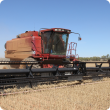Crops
The Department of Primary Industries and Regional Development continues to support the growth and international competitiveness of all crop industries in Western Australia.
With a 2400 kilometre span from its tropical north to its temperate south, WA supports a broad range of cropping industries from rain-fed winter cereals through to irrigated horticultural crops.
In the 2012/13 year the WA cropping industries exported a total of $3.9 billion which comprised: $3.1 billion of cereals, $859 million of pulses, pastures and oilseeds, $142 million of horticultural crops. The major contributors to these exports were wheat ($2.7 billion), canola ($756 million), barley ($377 million), lupins ($42 million), carrots at $48 million, oats ($12 million), and strawberries at $5.5 million.
Articles
Filter by search
Filter by topic
- (-) Remove Livestock & animals filter Livestock & animals
- Climate, land & water (5) Apply Climate, land & water filter
- (-) Remove Livestock management filter Livestock management
- (-) Remove Grains filter Grains
- (-) Remove Climate & weather filter Climate & weather
- Climate change (4) Apply Climate change filter
- Production & postharvest (2) Apply Production & postharvest filter
- Feeding & nutrition (2) Apply Feeding & nutrition filter
- Measuring and assessing soils (1) Apply Measuring and assessing soils filter
- Livestock species (1) Apply Livestock species filter
- Soil management (1) Apply Soil management filter
- Soils (1) Apply Soils filter
- Livestock research & development (1) Apply Livestock research & development filter
- Wheat (1) Apply Wheat filter
- Genetics & selection (1) Apply Genetics & selection filter
- Canola (1) Apply Canola filter
- Grains Research & Development (1) Apply Grains Research & Development filter
- Horticulture (1) Apply Horticulture filter
- Irrigated crops (1) Apply Irrigated crops filter
- Liming (1) Apply Liming filter






